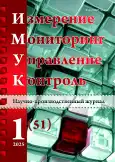CОСТОЯНИЕ И ТЕНДЕНЦИИ РАЗВИТИЯ ВИХРЕТОКОВЫХ ДАТЧИКОВ
- Авторы: Дмитриенко А.Г.1,2, Семкина К.А.1,2, Ульянин Н.С.1
-
Учреждения:
- Научно-исследовательский институт физических измерений
- Пензенский государственный университет
- Выпуск: № 1 (2025)
- Страницы: 59-69
- Раздел: ПРИБОРЫ И МЕТОДЫ ИЗМЕРЕНИЙ
- URL: https://journal-vniispk.ru/2307-5538/article/view/289576
- DOI: https://doi.org/10.21685/2307-5538-2025-1-8
- ID: 289576
Цитировать
Полный текст
Аннотация
Актуальность и цели. Актуальность темы обусловлена разнообразием областей применения и конструкций вихретоковых датчиков. Представленная информация соответствует современному состоянию методов и средств технических измерений и отражает последние достижения науки и техники в рассматриваемой области. Целью работы является аналитический обзор современных видов, описание областей применения и рассмотрение тенденций развития вихретоковых датчиков. Материалы и методы. С помощью вихретокового метода неразрушающего контроля можно оценивать состояние и механические свойства материалов, определять толщину слоя, выявлять дефекты в виде несплошностей, измерять расстояние между быстро движущимися объектами и т.д. Результаты и выводы. Вихретоковый метод неразрушающего контроля по сравнению с другими методами обладает ощутимыми преимуществами, а именно: точностью полученных результатов, многопараметровостью, бесконтактностью, слабым влиянием факторов внешней среды, автоматизацией.
Об авторах
Алексей Геннадиевич Дмитриенко
Научно-исследовательский институт физических измерений;Пензенский государственный университет
Автор, ответственный за переписку.
Email: info@niifi.ru
доктор технических наук, доцент, генеральный директор; заведующий кафедрой ракетно-космического и авиационного приборостроения на базе Научно-исследовательского института физических измерений
(Россия, г. Пенза, ул. Володарского, 8/10);(Россия, г. Пенза, ул. Красная, 40)Кристина Александровна Семкина
Научно-исследовательский институт физических измерений;Пензенский государственный университет
Email: po444t@mail.ru
специалист; магистрант
(Россия, г. Пенза, ул. Володарского, 8/10);(Россия, г. Пенза, ул. Красная, 40)Николай Сергеевич Ульянин
Научно-исследовательский институт физических измерений
Email: kolianul@mail.ru
начальник центра проектирования систем № 1
(Россия, г. Пенза, ул. Володарского, 8/10)Список литературы
- Грошков Е. П., Клюшев А. В., Кирпичев А. А., Редюшев А. А. Интеллектуальные вихретоковые датчиковые системы // Компоненты и технологии. 2009. № 1. С. 22–24.
- Бобров А. Л., Власов К. В., Бехер С. А. Основы вихретокового неразрушающего контроля. Новоси- бирск : СГУПСа, 2019. 98 с.
- Маркелов М. К. Разработка вихретокового преобразователя для измерения зазора // Труды Международного симпозиума Надежность и качество. 2011. Т. 2. С. 270–273.
- Грабовский А. В., Петров Г. А. Многоканальные сканеры вихретокового контроля // СПбГЭТУ «ЛЭТИ». 2016. № 9. С. 42–48.
- verifiedmarketreports.com. URL: https://www.verifiedmarketreports.com/ru/blog/top-7-emerging-trendsshaping- the-future-of-the-inductive-position-sensors-market (дата обращения: 18.10.2024).
- Новиков В. Н., Ульянин Н. С., Цыпин Б. В. Модель стабилизации вихретоковых датчиков перемещения // Измерение. Мониторинг. Управление. Контроль. 2018. № 3. С. 58–68. doi: 10.21685/2307- 5538-2018-3-8
- Семкина К. А. Вихретоковые датчики. Устройство, преимущества и недостатки, аналитический обзор современных видов датчиков // Труды Международного симпозиума Надежность и качество. 2024. Т. 2. С. 269–271.
- Бакли Д. М. Введение в теорию и технологию вихретокового тестирования. URL: http://joe.buckley.net/ papers/eddyc.pdf (дата обращения 18.10.2024).
- Мигель А. Конструкция вихретокового датчика для неразрушающего контроля: обзор // Датчики. 2024. № 17. С. 42. doi: 10.3390/s24175819 ISSN 1424-8220
- SURAGUS. URL: https://www.suragus.com/en/technology/ (дата обращения 18.10.2024).
- ets-ndt.ru. URL: https://ets-ndt.ru/azbuka/metod-vikhretok/?ysclid=m2hpqvn36o840410814 (дата обращения 18.10.2024).
- Проскуряков М. В., Силин А. М., Нижегородов В. В. Вихревые токи (Токи Фуко) // Новые технологии науки, техники, педагогики высшей школы : материалы Междунар. науч.-практ. конф. М., 2017. С. 425–428.
- Малащук А. М., Сычик А. В. Вихревые токи Фуко // Актуальные проблемы энергетики. 2016. № 1. С. 487–488.
- Маликов В. Н. Контроль неоднородностей, примесей и дефектов проводящих сплавов и композиционных материалов с помощью сверхминиатюрных вихретоковых преобразователей : дис. … канд. техн. наук. Барнаул, 2019. 151 с.
- Федосенко Ю. К., Шкатов П. Н., Ефимов А. Г. Вихретоковый контроль. М. : Спектр, 2011. 223 с.
- Ульянин Н. С., Тужилкин О. В. Применение нейронных сетей для повышения метрологических характеристик датчиков при измерении динамических процессов // Датчики и системы. 2012. № 9. С. 41–44.
Дополнительные файлы





















